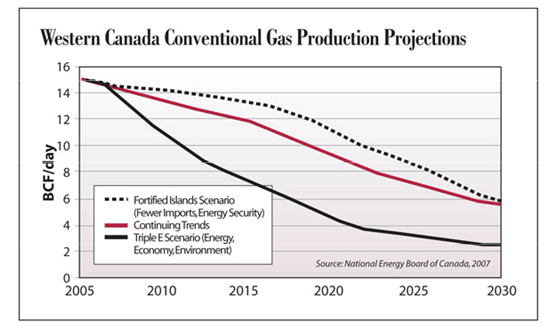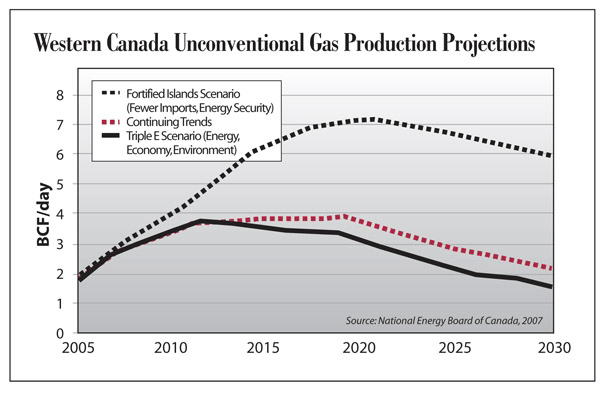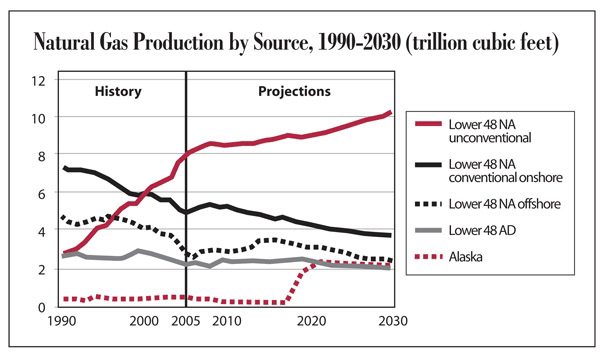|
FRIDAY EDITION December 26th, 2025 |
|
Home :: Archives :: Contact |
 |
The Casey Files: The Push Toward Unconventional GasBy: Dr. Marc BustinSenior Researcher, Casey Energy Division Casey Research February 16, 2008
The Push Toward Unconventional Gas The push toward unconventional gas - also called nonconventional gas - is a direct result of North America's dwindling reserves of conventional gas. As with oil, we've been using up the cheap and easy-to-extract natural gas resources first, and we're now compelled to search out deposits of a less conventional nature. How severe could the drop-off in conventional gas production be? Within Western Canada, the National Energy Board of Canada (NEB) projects that production rates will decline between 64 and 79% by 2030. 
Unconventional gas production, on the other hand, is growing fast. 
The same story holds true for the Lower 48 in the U.S where production of unconventional gas already outstrips conventional gas.  So certainly it's safe to say that unconventional gas (and to a lesser degree, liquid natural gas or LNG imports) shows potential for growth. But the savior to our impending energy shortfall? That's another animal. To get a better grip on the true viability of unconventional gas, we need to take a closer look at the geology involved. Conventional vs. Unconventional To understand what unconventional gas resources are, we need to start by understanding how they differ from conventional gas resources. Natural gas is predominately methane. This methane is generated when sedimentary rocks containing organic matter are exposed either to bacteria at shallow depths in the earth (<1500 meters) or to high temperatures at greater depths. Sedimentary rocks in the subsurface normally contain water in their pores or fractures and thus, when the organic matter chemically transforms into hydrocarbons, the gas and oil - being lighter than the surrounding water - exert an upward force that results in a movement known as migration. The hydrocarbons' migration upward will continue as long as the rock's pores and fractures are sufficiently interconnected, a characteristic that geologists define as permeability. However, should they encounter rocks with low permeability, called seal rocks, migration stops and the hydrocarbons become trapped. To be an economically viable oil and gas deposit, the rocks below the trapping seal rock must have three properties in sufficiency: volume, porosity and permeability. That's how a company can produce at rates and volumes great enough to pay for the well and associated expenses, and then return a profit. To summarize, for a workable conventional gas or oil deposit you need three things. The first is source rock with organic matter that has generated gas or oil in sufficient volumes, the second is a reservoir in which migrating hydrocarbons can accumulate, and the third is a trap. If a company's project is missing any one of these three key elements in their deposit, or if one element is compromised, we would have been better off leaving our money in our mattress. Let's note that there are no hard and fast rules to follow. For example, gas will flow at economic rates in rocks with much lower permeability than would be economic for oil. Also, at greater depths, natural gas comes under greater pressure; so even with low porosity and permeability, we may be able to produce at economic rates and volumes. This is only an overview of conventional gas resources, but it provides the framework to understand what makes certain gas resources "unconventional." Details on that are coming, but first, a bit of history to set it up. Born From an Energy Crisis The impetus for significant unconventional gas production can be traced back to the U.S. implementation of the Windfall Profit Tax on energy companies in 1980. Some of those funds were diverted for the Alternative Fuel Production Credit, which was established to encourage the production of domestic energy from nonconventional sources. The aim was to reduce dependence on energy imports, a goal that America is still far from meeting. Part of this production credit was applied to Devonian shale, coal seams, and tight formations. The substantial tax incentive spurred unconventional gas exploration into action, and even though the incentive has now expired, its legacy is evident. Today, unconventional production is the fastest-growing part of the gas industry in the U.S. (and a very important part of the Canadian market). In the continental U.S., eight of the top ten gas fields are producing from unconventional gas resources. In Canada, there was never a tax credit. Because of Canada's relatively higher conventional gas resources, the unconventional gas industry has been slower to evolve. Elsewhere in the world, unconventional gas is in its infancy and, with the exception of coalbed methane in Australia, there have been no major successes… although substantial amounts of investors' money has been spent. When Unconventional Becomes Inaccessible - Watch Out! The biggest risks that come with developing unconventional gas resources relate to permeability and reservoir access. The size of unconventional gas reservoirs is commonly measured in trillions of cubic feet (tcf) and in tens to hundreds of billions of cubic feet per section (bcf/section). Compared with the size of conventional gas resources, these numbers are staggering and may send you racing for your check book. But wait! Check out the stock performance of a few companies that have been chasing the tremendous coalbed methane resources in China, the high-rank coals in British Columbia, or the companies that raced into the Palo Dura basin in Texas. It takes more than resource size to make a great find. With coals, because of the nature of the material, the permeability may be too low for economic production - even at shallow depths in areas of high stress. There are currently no coals deeper than about 1,200 meters that are producing at economic rates. Examples of this have occurred in Western Canada and Colorado, where deeper coals that have the highest gas content are proving uneconomic in many areas. Putting horizontal wells into coal seams (except in a few special areas) hasn't worked either. Permeability is also a major problem with gas shales. Shales, because of their low natural permeability, must be artificially fractured to increase the flow rates. This process is part of completing a well, and is normally carried out by injecting very high volumes of water under high pressure either into vertical or, now more common, horizontal well bores. Completing the well is enormously expensive and thus do not always make for a profitable adventure. Keys to Exploration Success The days of small-cap companies tying up land underlain by coal or shale, calculating a big resource number and rushing blindly to the market to raise money are gone… or at least we hope so. The good news is that despite the technical challenges and costs involved, there are some excellent companies and investment opportunities in the unconventional field. You'll need to evaluate them closely, however. So how do we evaluate an unconventional gas company? Below is our synopsis. Land Position: Clearly, a land position in a basin with good potential is crucial. Unconventional gas wells are invariably drilled with greater density than conventional wells - that is, more wells per given area - and thus they require more pipelines, compressors, infrastructure, and so on. Since many wells, especially coal wells, produce at low rates (< 300 mmcf/day), the land position needs to be contiguous for economic development. The need for lengthy pipelines or environmental restrictions, for example, may kill a great prospect. So land-related economic issues need close examination. A Technologically Competent Management Team: Unconventional gas resources require a team of geologists and engineers who know what they are doing. Having a board made up of celebrities may garner a company attention but few solutions in these complex and challenging reservoirs. Access to Capital: In fairly well-developed and understood coalbed methane plays, such as the Powder River Basin (Colorado), San Juan (New Mexico), Black Warrior Basin (Alabama) or the Horseshoe Canyon play (Alberta), companies with limited capital access but a land position can be, and are, successful. But in deeper coals, where wells are expensive (> $1 million) and in which technological issues (mainly related to low permeability) are not solved, the cost rapidly becomes prohibitive. In that case, small companies with good land positions may be prudent to farm out some of their land. Basins that require protracted dewatering of the coal to promote gas production also require deep pockets, patient investors, and probably all three. Gas shales are even more capital intensive than coalbed methane. In Canada, the hottest gas shale prospect is the Horn River Basin of northeastern British Columbia (BC). The Horn River Basin attracted industry attention initially because of a regional study done in 2004 by CBM Solutions for the BC government (available at www.em.gov.bc.ca/subwebs/oilandgas/petroleum_geology/uncog/shale.htm#Studies). This study shows the presence of a thick sequence of Devonian-age shale with attributes similar to those of the Barnett Shale in the Fort Worth Basin - the most productive shale basin in the world. The Horn River Basin is larger, the shales thicker, and many geologists think the shales there are even more prospective than those of the Fort Worth Basin. As a result, many of the major companies working the Barnett turned their attention north, which has led to the current land rush. Over the last two years land prices have been astonishing, with the most recent crown sale in the Horn River Basin yielding C$3,000/hectare. In these areas well costs are in the multimillions, infrastructure is limited, and drilling is seasonal. The results of the initial drilling in the Horn River Basin are still confidential. (In BC, an experimental scheme allows the operators to keep the data from drilled wells confidential for a period up to 10 years.) The only announcement to date came on July 9, 2007, when Apache indicated it hoped to commercialize its shale gas play soon. Much of the land acquisition has been by broker, but from what we can tell, it appears that small-cap companies have been frozen out of this play due to high land prices and development costs. Elsewhere in the U.S. and Canada, there are opportunities for small-cap companies in the gas shale business, but we'll note again… land and a technology-competent team are critical. So here's the bottom line: Without all three of these factors - land position, technical know-how, and capital - an exploration company looking to profit from unconventional gas resources will flounder. Unconventional gas companies must be examined against a stricter set of criteria than conventional exploration plays because of complications involved with unconventional resources. However, a company that can manage to navigate all these obstacles successfully is poised to participate in one of the fastest-growing fields in the booming energy sector. You must be an intrepid investor willing to weather a few storms if you want to participate in these cutting-edge unconventional gas plays. There are plenty of juniors in the sector trying to pass off inaccessible reserves as a lucrative resource, but there are also a few teams who have proven that they can sniff out an opportunity before it becomes a trend. The Casey Research energy team seeks out these opportunities for our Casey Energy Speculator subscribers. Try a risk-free, 3 month trial subscription by clicking here. If you're not happy with the research we do (or want to cancel for any reason) do so within the first three months and get a full refund - but keep all the research, special reports and other information you receive with your subscription. This report is made possible by the team of researchers and analysts at the Casey Energy Speculator - the go-to newsletter for investors exploring the profit potential in the fast-moving energy markets. From exploratory oil and natural gas companies to burgeoning uranium mines, CES provides investors the information and insights needed to identify the truly lucrative opportunities from the merely promising. For your opportunity to explore these possibilities along with the CES team, click here now for a special three month, no-risk, no-obligation trial subscription. The Casey Energy Speculator is published by Casey Research, the finest team of natural resource and precious metals investment analysts in the world today. By: Dr. Marc Bustin Senior Researcher, Casey Energy Division Casey Research info@caseyresearch.com February 16, 2008 |
| Home :: Archives :: Contact |
FRIDAY EDITION December 26th, 2025 © 2025 321energy.com |
|